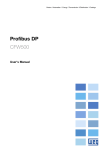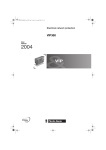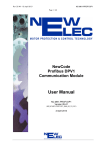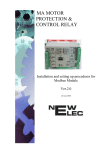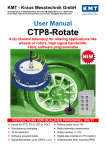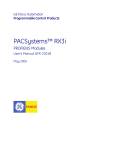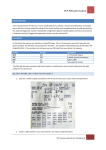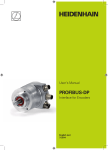Download KD Profibus User Manual
Transcript
KE-PROFI-DP0 Page 1 / 18 KE-Relay or KD-Relay Profibus DPV0 Communication Module User Manual KE-PROFI-DP0 Version 01.04 (NE_NC-KE-PROFI-DP0_MAN_01_10_FN04) 28 June 2010 NewElec Pretoria (Pty) Ltd Head Office: c/o 298 Soutter street & Maltzan street Pretoria West South-Africa 0182 GPS: 25°45'12''S 28°09'46''E Http://www.newelec.co.za KE-PROFI-DP0 Page 2 / 18 Content 1. ABSTRACT............................................................................................................................3 2. SPECIFICATIONS.................................................................................................................4 2.1 Technical Specifications of KE-PROFI-DP0....................................................................4 2.2 Structure Of The Parametrization Telegram.....................................................................5 2.2.1 KE-Relay Pointer Table.............................................................................................8 2.2.2 Input Pointers 1 .......................................................................................................10 2.3 Cyclic Out Byte...............................................................................................................12 2.4 Diagnostics......................................................................................................................13 3. DEFINITIONS AND TERMINOLOGY..............................................................................14 4. FUNCTIONAL DESCRIPTION..........................................................................................15 5. OPERATING INSTRUCTIONS...........................................................................................16 5.1 Getting Started................................................................................................................16 5.1.1 Setting Up The KE-PROFI-DP0..............................................................................16 5.1.2 Installing Of NC-MK1-PROFI-DP1 GSD File........................................................16 6. DIAGRAMS.........................................................................................................................17 6.1 Block Diagram of NC-MK1-PROFI-DP1......................................................................17 7. PROFIBUS GSD REGISTERED.........................................................................................18 KE-PROFI-DP0 Page 3 / 18 1. ABSTRACT The KE-PROFI-DP0 (KE or KD-Relay Profibus DPV0) acts as a translator between the Profibus SCADA and the KE or KD-Relay. It is advisable to read the KE or KD user manual, as some of the topics will require knowledge on the KE or KD. It is also advisable to have knowledge on profibus. Information on profibus can be found at the web site www.profibus.com. The communication protocol between the KE-PROFI-DP0 and SCADA is Profibus DPV0 class 1. Communication protocol between the KE-PROFI-DP1 and the KE or KD Relay is a NewElec proprietary protocol. Enabling the PLC to communicate with the KE or KD-Relay via Profibus DPV0. KE-PROFI-DP0 Page 4 / 18 2. SPECIFICATIONS 2.1 Technical Specifications of KE-PROFI-DP0 General Data NC-MK1PROFI-DP0 Mounting Positions Allowed Ambient Temperature Humidity Power Supply Consumption Communication Mediums Profibus Indication Lights Protocol Baud Rate Cable Length @ Baud Rate Termination Resistor (Termination resistors must be connected at the beginning and end of bus) Type LED Indications ● ● ● ● ● ● ● ● ● ● ● ● ● ● ● ● External module. Operation : 0 ºC to +60 ºC < 87% 220 Vac 110 Vac 180 mA Profibus RS232 Profibus DPV0 9600 bit/s to 12 Mbit/s 1200 m @ 9600 bit/s to 45450 bit/s 1000 m @93.75Kbit/s to 187.5Kbit/s 400 m @ 500 Kbit/s 200 m @ 1.5 Mbit/s 100 m @ 3 Mbit/s to 12 Mbit/s 220 Ohm. ● Light Emitting Diode (LED) ● SCADA Communication ● KE or KD Communication KE-PROFI-DP0 Page 5 / 18 2.2 Structure Of The Parametrization Telegram The parametrization telegram data will look as follow: Byte Parameter Name Addr Description 1 Profibus Config A Configuration byte of the KE-PROFI-DP0: • Bit 0 = Parametrize Settings. • Bit 1 = Parametrize Logic Function. • Bit 2 ~ 6 = Reserved. • Bit 7 = Fail Safe Disabled. 2 Din Amount of words from the Relay to the SCADA. 3 ~ 7 Word 1 ~ 5 To SCADA Pointer to KE-Relay Pointer Table (2.2.1). Range Set 1~5 0 ~ 12 8 Unbalance Trip Level Trip level for unbalance in %. 9 Unbalance Trip Delay Unbalance trip delay in seconds. 0~99 10 Voltage selection Select the line voltage of the relay. • 0 = Auto. • 1 = 110 Vac. • 2 = 400 Vac. • 3 = 525 Vac. • 4 = 1050 Vac. 0~4 11 Volt. Sym. Trip Level Voltage symmetric trip level in %. 0 ~ 100 12 Starts Per Hour Amount of starts that can be taken in a hour. 1 ~ 30 13 Consecutive Starts Amount of starts to be take after a failed start attempt. 1~3 14 ~ 15 Earth Leak Trip Level Earth leakage trip level in mA. 16 ~ 17 Earth Leak Trip Delay Delayed time for earth leakage in ms with 50 ms incremental. 0 ~ 100 0 ~ 999 100 ~ 1000 Earth Leakage Trip Type Type of earth leakage trip. 18 • • 0 = Instantaneous. 1 = IDMT. 0~1 19 Max. Load Setting Maximum load setting of the relay in %. 10 ~ 100 20 TC Curve Thermal capacity curve selected in %. 3 ~ 40 21 TC Reset Threshold Thermal capacity reset level in %. 1 ~ 10 22 ML Reset Timer Time to reset the relay after minimum load trip. • 0 = Manual. • 1 = 10 Seconds. • 2 = 5 Minutes. • 3 = 10 Minutes. • 4 = 20 Minutes. 0~9 KE-PROFI-DP0 Page 6 / 18 • • • • • 5 = 30 Minutes. 6 = 45 Minutes. 7 = 1 Hour. 8 = 3 Hours. 9 = 6 Hours. 23 ML Current Trip Level Minimum load trip level in %. 0 ~ 100 24 ML Power Trip Level 0 ~ 100 25 ML Startup Trip Delay seconds. 1 ~ 200 26 ML Trip Delay 0 ~ 10 Minimum load power trip level %. Time to delay minimum load trip at start up in Delay run time trip delay in seconds. 27 ~ 28 Running Stall Level Running stall trip level in %. 29 ~ 30 Run. Stall Hold Time Running stall hold off time in seconds. 110 ~ 300 0 ~ 200 Control Byte A Control byte A: • Bit 0 = Minimum load disabled. • Bit 1 = Under voltage disabled. • Bit 2 = Over voltage disabled. • Bit 3 = Voltage Symmetric disabled. • Bit 4 = Fail safe disabled. • Bit 5 = Unbalance disabled. • Bit 6 = Phase rotation disabled. • Bit 7 = Short circuit disabled. Control Byte B Control byte B: • Bit 0 = Single phase disabled. • Bit 1 = Running stall disabled. • Bit 2 = ML = power factor selected. • Bit 3 = Earth leakage disabled. • Bit 4 = Low pass filter disabled. • Bit 5 = Insulation lockout disabled. • Bit 6 = Frequency disabled. • Bit 7 = Auto calc. TC reset disabled. 33 Control Byte C Control Byte C: • Bit 0 = Starts per hour disabled. • Bit 1 = Phase rotation reversed. • Bit 2 = Vectorial stall disabled. • Bit 3 = Auto reset. • Bit 4 ~ 7 = Reserved. 34 Logic Function 1 Mask Logic function 1 mask register. 35 LF 1 A Input pointer Input Pointers 1 (2.2.2). 0 ~ 50 36 LF 1 B Input pointer Input Pointers 1 (2.2.2). 0 ~ 50 37 LF 1 C Input pointer Input Pointers 1 (2.2.2). 0 ~ 50 31 32 0 ~ 255 KE-PROFI-DP0 Page 7 / 18 38 Logic Function 2 Mask Logic function 2 mask register. 39 LF 2 A Input pointer Input Pointers 1 (2.2.2). 0 ~ 50 40 LF 2 B Input pointer Input Pointers 1 (2.2.2). 0 ~ 50 41 LF 2 C Input pointer Input Pointers 1 (2.2.2). 0 ~ 50 42 Logic Function 3 Mask Logic function 3 mask register. 43 LF 3 A Input pointer Input Pointers 1 (2.2.2). 0 ~ 50 44 LF 3 B Input pointer Input Pointers 1 (2.2.2). 0 ~ 50 45 LF 3 C Input pointer Input Pointers 1 (2.2.2). 0 ~ 50 46 ~ 47 Timer A Time Out Time for timer A to time out in seconds. 0 ~ 255 0 ~ 255 0 ~ 3000 48 Timer A Start Input Ptr Input Pointers 1 (2.2.2). 0 ~ 50 49 Timer A Stop Input Ptr Input Pointers 1 (2.2.2). 0 ~ 50 50 ~ 51 Timer B Time Out Time for timer B to time out in seconds. 0 ~ 3000 52 Timer B Start Input Ptr Input Pointers 1 (2.2.2). 0 ~ 50 53 Timer B Stop Input Ptr Input Pointers 1 (2.2.2). 0 ~ 50 54 RTC Start Hour Real time clock start hours. 0 ~ 23 55 RTC Start Minutes Real time clock start minutes. 0 ~ 59 56 RTC Stop Hour Real time clock stop hours. 0 ~ 23 57 RTC Stop Minutes Real time clock stop minutes. 0 ~ 59 58 Relay 2 Input Ptr Input Pointers 1 (2.2.2). 0 ~ 50 KE-PROFI-DP0 Page 8 / 18 2.2.1 KE-Relay Pointer Table Values that can be routed to for the PLC words in 1 to 5. Address Name 0 TC remaining 1 Current Level. 2 Red Phase Voltage Level. 3 White Phase Voltage Level. 4 Blue Phase Voltage Level. 5 Actual Power 6 Alarm Flags • Bit 0 = In Service. • Bit 1 = Earth Leakage. • Bit 2 = Over Current. • Bit 3 = Running Stall. • Bit 4 = Unbalance. • Bit 5 = Single Phase. • Bit 6 = Minimum Load. • Bit 7 = Short Circuit. • Bit 8 = Voltage Present. • Bit 9 = Over Voltage. • Bit 10 = Under Voltage. • Bit 11 = Voltage Symmetric. • Bit 12 = Insulation Lockout. • Bit 13 = Low Frequency. • Bit 14 = High Frequency. • Bit 15 = Earth Fault. 7 Trip Flags • Bit 0 = Over Current. • Bit 1 = Running Stall. • Bit 2 = Unbalance. • Bit 3 = Single Phase. • Bit 4 = Minimum Load. • Bit 5 = Short Circuit. • Bit 6 = Phase Rotation. • Bit 7 = Earth Fault. • Bit 8 = Over Voltage. • Bit 9 = Under Voltage. • Bit 10 = Voltage Symmetric. • Bit 11 = Insulation Lockout.. KE-PROFI-DP0 Page 9 / 18 • • • • Bit 12 = Low Frequency. Bit 13 = High Frequency. Bit 14 = Earth Fault. Bit 15 = Starts Per Hour. 8 Voltage Symmetric Level 9 Earth Leakage Level. 10 Frequency 11 Insulation Lockout 12 Function Flags. • Bit 0 = Logic Function 1. • Bit 1 = Logic Function 2. • Bit 2 = Logic Function 3. • Bit 3 = Timer A. • Bit 4 = Timer B. • Bit 5 = Real Time Clock. • Bit 6 = Main Trip Relay. • Bit 7 = Relay 2. 13 Apparent Power Consumption 14 Real Power Consumption KE-PROFI-DP0 Page 10 / 18 2.2.2 Input Pointers 1 It is signals that can be routed to the inputs of the logic functions, timers and relays. Address Name 0 Constant Zero 1 Constant One 2 In Service Flag 3 Voltage Present Flag 4 Over Current Alarm Flag 5 Short Circuit Alarm Flag 6 Running Stall Alarm Flag 7 Unbalance Alarm Flag 8 Single Phase Alarm Flag 9 Earth Fault Alarm Flag 10 Earth Leakage Alarm Flag 11 Minimum Load Alarm Flag 12 Over Voltage Alarm Flag 13 Under Voltage Alarm Flag 14 Voltage Symmetric Alarm Flag 15 High Frequency Alarm Flag 16 Low Frequency Alarm Flag 17 Insulation Lockout Alarm Flag 18 Over Current Trip Flag 19 Short Circuit Trip Flag 20 Running Stall Trip Flag 21 Unbalance Trip Flag 22 Single Phase Trip Flag 23 Earth Fault Trip Flag 24 Earth Leakage Trip Flag 25 Minimum Load Trip Flag 26 Over Voltage Trip Flag 27 Under Voltage Trip Flag 28 Voltage Symmetric Trip Flag 29 High Frequency Trip Flag 30 Low Frequency Trip Flag 31 Insulation Lockout Trip Flag 32 Phase Rotation Trip Flag KE-PROFI-DP0 Page 11 / 18 33 Starts Per Hour Trip Flag 34 Timer A Output 35 Inverted Timer A Output 36 Timer B Output 37 Inverted Timer B Output 38 RTC Output 39 Inverted RTC Output 40 Logical Function 1 Output 41 Inverted Logical Function 1 Output 42 Logical Function 2 Output 43 Inverted Logical Function 2 Output 44 Logical Function 3 Output 45 Inverted Logical Function 3 Output 46 Restart Flag 47 Frozen Contact Flag 48 PLC Bit 0 49 PLC Bit 1 50 TC > TC warning level. KE-PROFI-DP0 Page 12 / 18 2.3 Cyclic Out Byte The message from the PLC to the slave will look as follow: Byte :: Bit Description 0::0 PLC bit 0 0::1 PLC bit 1 0::2 ~ 5 Reserved 0::6 Reset Relay 0::7 Fail safe communication between relay and slave is disabled KE-PROFI-DP0 Page 13 / 18 2.4 Diagnostics Diagnostic message will look as follow: Byte Description 0~2 Station status as per DP specifications. 3 Master profibus address. 4~5 Manufacture ID. 6 Diagnostic Length. 7~8 Alarm Flags. 9 ~ 10 Trip Flags. 11 Function Flags 12 Profibus Status. • Bit 0 = Communication failure with KE or KD-Relay. 13 ~ 14 Startup Counter. 15 ~ 16 Trip Counter. 17 ~ 18 Running Hour Counter. 19 ~ 20 Apparent Power Consumption. 21 ~ 22 Real Power Consumption. KE-PROFI-DP0 Page 14 / 18 3. DEFINITIONS AND TERMINOLOGY EEPROM Electrical Erasable Programmable Read Only Memory (non volatile) Flash memory Similar to EEPROM (only block write - non volatile) In service When the current rise above 10% of full load current it is assumed that the motor is running. Intrinsic safe It is a protection technique for safe operation of electronic equipment in explosive atmospheres. The concept was developed for safe operation of process control instrumentation in hazardous areas. The theory behind intrinsic safety is to ensure that the available electrical and thermal energy in the system is always low enough that ignition of the hazardous atmosphere cannot occur. LED Light emitting diode (It is used as visual indicators) Motor protection relay It is an intelligent (computerized) unit monitoring an electric motor's current and voltage supply. In case of overloading, phase lost etc. the power supply of the motor will be interrupted by the protection relay to prevent damage to the motor. Dout Data send from the PLC to the slave device. Din Data received by the PLC from a slave device. KE-PROFI-DP1 KE / KD-Relay Profibus module with DPV0 capability. PLC Programmable Logic Controller. KE-PROFI-DP0 Page 15 / 18 4. FUNCTIONAL DESCRIPTION The KE-PROFI-DP0 can be broken down into the following function blocks: • Micro-Controller • KE / KD-Relay Interface. • Profibus Interface. • Light Emitting Diodes (LED) Micro-Controller – Is the core of the system. The micro-controller ensures that the operation of the KE-PROFI-DP0 gets executed. The micro-controller acts as a bridge between the KE / KD-Relay and the PLC. KE / KD-Relay Interface – Is the communication bus between the KE / KD-Relay and KEPROFI-DP0. With the KE / KD-Relay interface it is possible for the two micro-controllers KE / KD-Relay and KE-PROFI-DP0 to exchange data. Profibus Interface – Allows the KE / KD-Relay to communicate with the PLC. With the profibus interface it is possible to update the KE-PROFI-DP0 with new values as well as the PLC. Light Emitting Diodes – Allows the KE-PROFI-DP0 to indicate conditions to the operator. KE-PROFI-DP0 Page 16 / 18 5. OPERATING INSTRUCTIONS 5.1 Getting Started 5.1.1 Setting Up The KE-PROFI-DP0 Following must be done via the KE-PROFI-DP0 front-end: • Connect the KE-PROFI-DP0 to the front-end via the RS232 port. • Set the address of the KE-PROFI-DP0. • Transmit the data to the KE-PROFI-DP0. 5.1.2 Installing Of NC-MK1-PROFI-DP1 GSD File Following steps must be taken to install the GSD File: • Import the NewElec NEWEFF881.gsd into the STEP7 GSD directory. • Insert the KE-PROFI-DP0 device into the hardware configuration of the STEP7 program. • Set the KE-PROFI-DP0 stations address in the PLC hardware configuration. The address must match the address in the KE-PROFI-DP0. • Set the parametrization of the KE-PROFI-DP0. • Make sure that the cyclic Din matches those of the KE-PROFI-DP0 parametrization bytes. KE-PROFI-DP0 Page 17 / 18 6. DIAGRAMS 6.1 Block Diagram of NC-MK1-PROFI-DP1 KE / KD-Relay Interface Micro-Controller With Memory Profibus Interface LED KE-PROFI-DP0 Page 18 / 18 7. PROFIBUS GSD REGISTERED ----ooOoo----





















